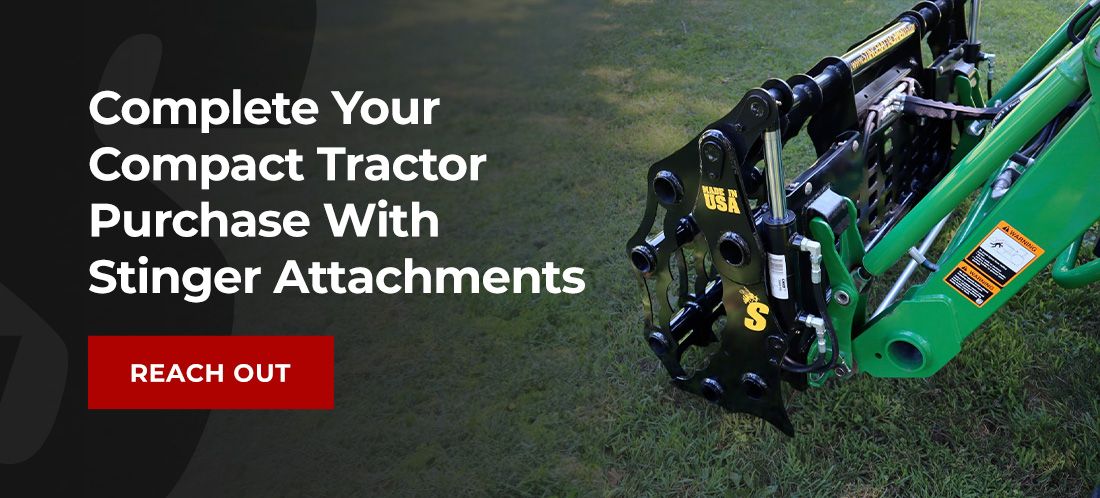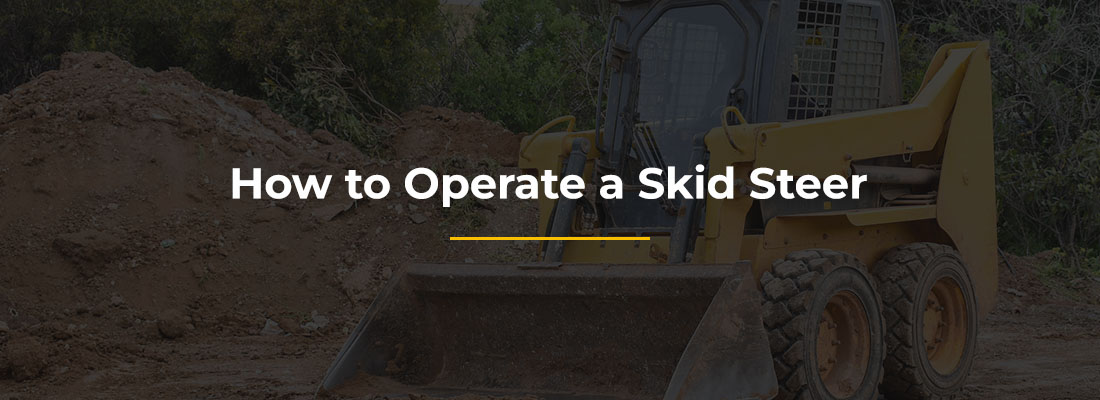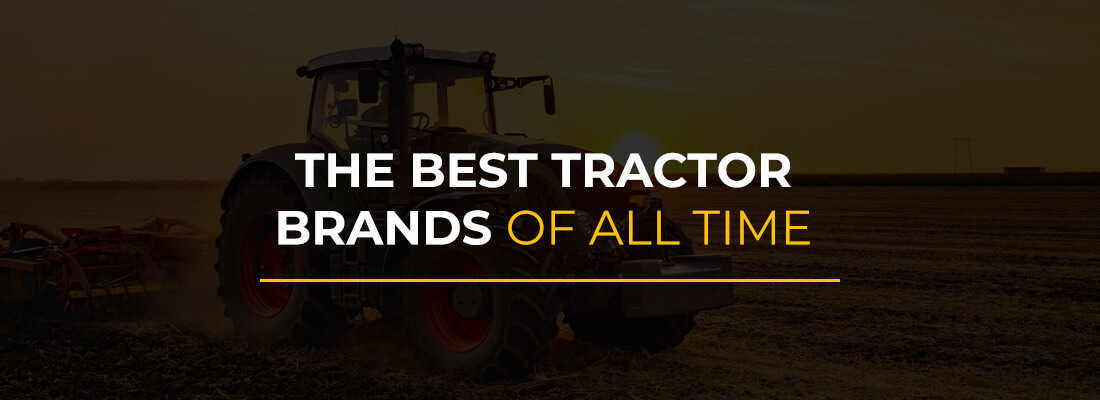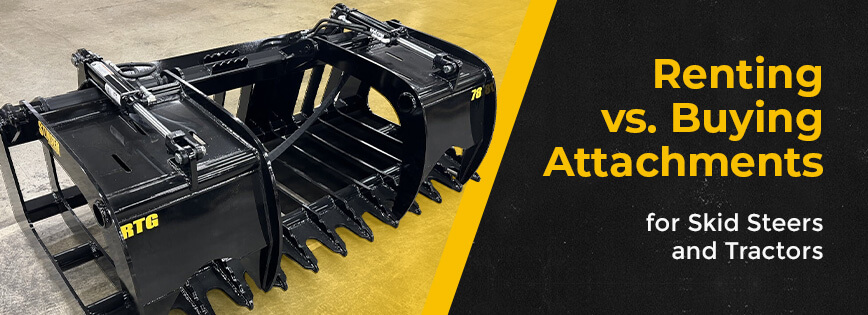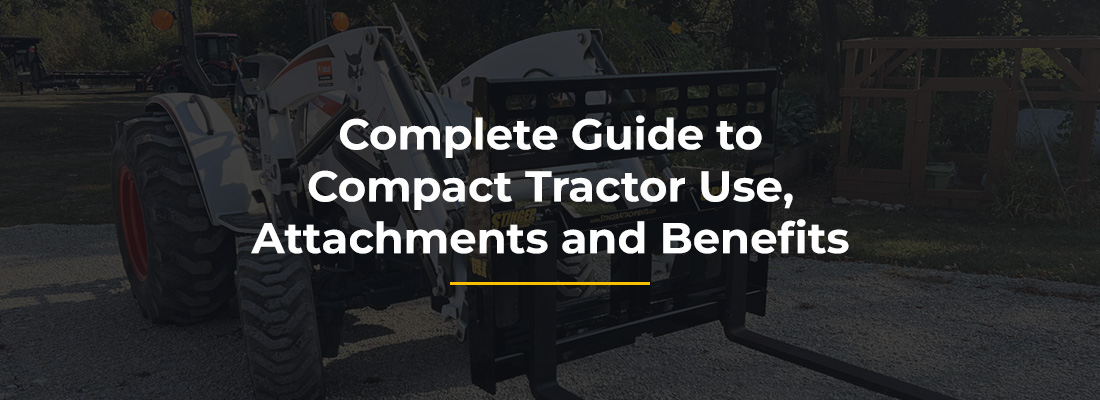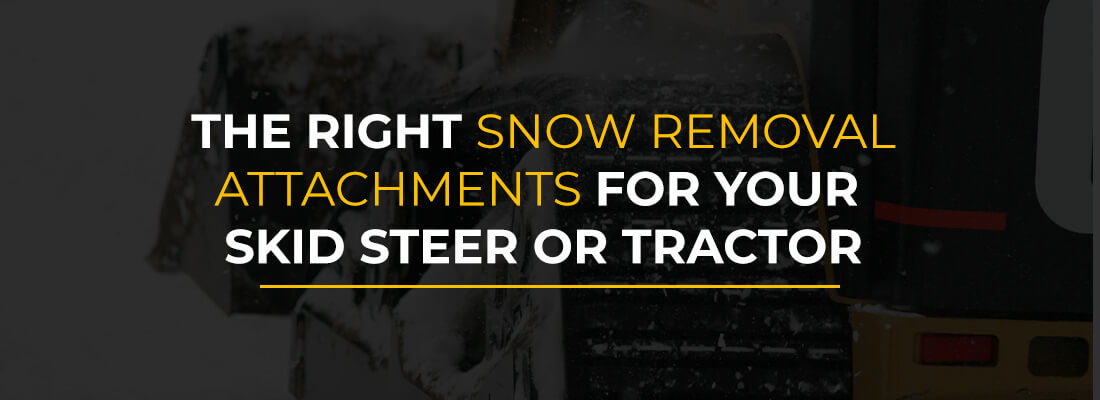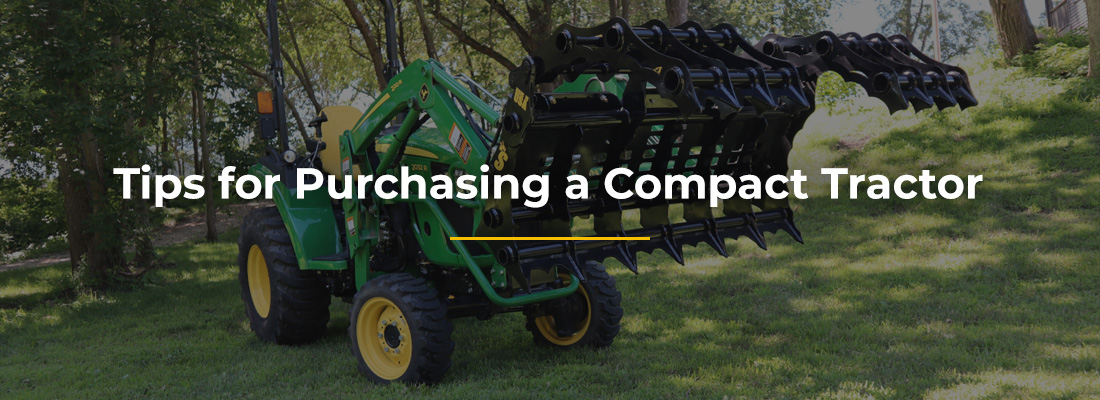
If you’re in the market for a compact tractor, you probably know how critical it is to find one well-suited to your projects. Just as you would when buying a new car, you must compare many factors related to your work and preferences to choose the best fit. In this guide, we’ve compiled tips for purchasing a compact tractor for beginners and veterans alike.
Matching Your Compact Tractor to Your Application
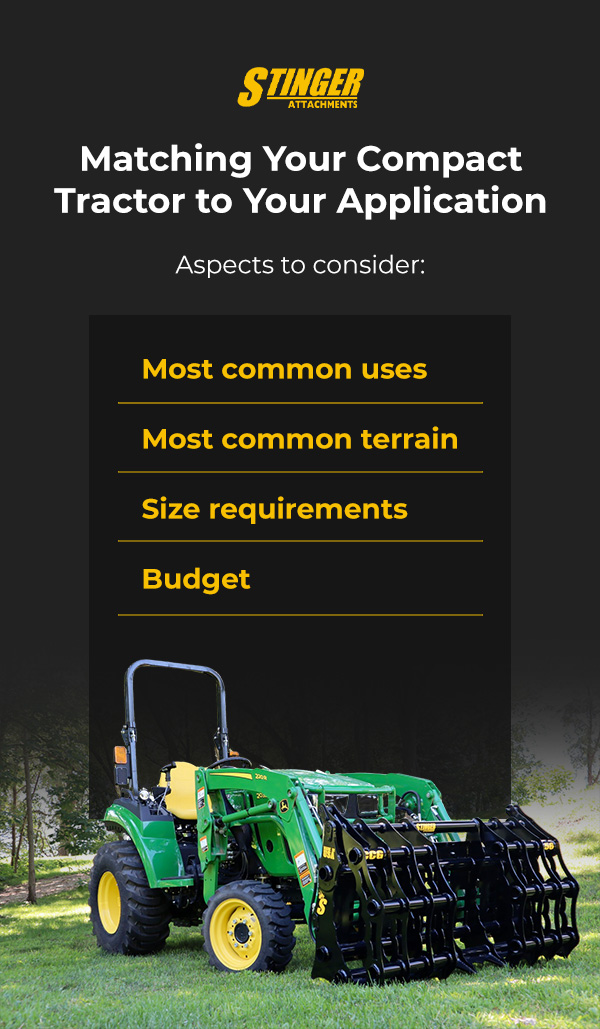
Start by analyzing your typical workday to figure out how you’ll use the equipment. You probably have a general idea, but nailing down the details can help you get the most bang for your buck. Here are some aspects to consider.
- Most common uses: Do you want to use the tractor primarily for towing a trailer, lifting items, grading soil or doing something else? Get a rough prediction of the expected weight of your loads, how often you’ll carry them and any unique requirements your work might have, such as oddly shaped loads.
- Most common terrain: Working on a well-maintained, flat field will call for a different tractor than a hilly landscape with rocks or tree roots. Identify the terrain you’ll drive on most frequently.
- Size requirements: While they fit into the compact category, compact tractors still vary in size. Consider whether you’d prefer a larger tractor that might carry heavier loads and move faster or a smaller model that offers better maneuverability with a more modest carrying capacity.
- Budget: Decide how much you can spend on your compact tractor. Include your projected maintenance costs and any attachments and accessories you plan to buy.
Think ahead as you figure out your must-haves and nice-to-haves. Do you plan to grow your business or take on different jobs? Will you need to add attachments? Consider what kind of work you might do in the future and whether slightly oversizing your tractor might be a good idea.
Say you’re trying to decide between a smaller tractor and a more robust model for various tasks on a livestock farm, but you’ve been thinking about ramping up operations in the next few years. By sizing up your compact tractor, you can ensure it fits the tasks you do today and those you might do later, such as moving heavy pallets of feed or clearing away trees to build a new pen.
New vs. Used Compact Tractors
As with cars, you can choose between new and used compact tractors. A new tractor ensures a clean history, modern features, low maintenance requirements and warranty availability. You can often find financing deals for new models, such as low interest rates or rebates. A new tractor is a good choice if you want the latest and greatest or top-notch reliability. They’ll typically cost more and depreciate quickly, but the warranty benefits and reduced maintenance requirements can help offset the price.
Buying a used compact tractor can net you big-time savings. Of course, used options are cheaper, and they depreciate more slowly. But you’ll need to do a little homework to get these savings. Look for a well-maintained model with low usage. Before buying a used tractor, ask plenty of questions, such as:
- Can I see maintenance records?
- What are the total miles and operating hours?
- How many owners has it had?
- Has it ever had parts replaced?
- Are there any attachments or accessories included?
- How old are the tires?
- What kind of projects has it worked on in the past?
- Do you offer a warranty or return policy?
You might forego an inspection if you have a trustworthy dealer, but this step is essential when buying from an individual seller. Bring a licensed mechanic to check out the exterior, engine and hydraulics, and always take a test drive. Ensure it functions properly and you like the way it drives, the cab design, etc.
6 Tips for Purchasing a Compact Tractor
Before buying a compact tractor, you’ll need to know your options and how these machines work. Use these six tips to make a more informed decision on your compact tractor.
1. Select a Model With Enough Horsepower
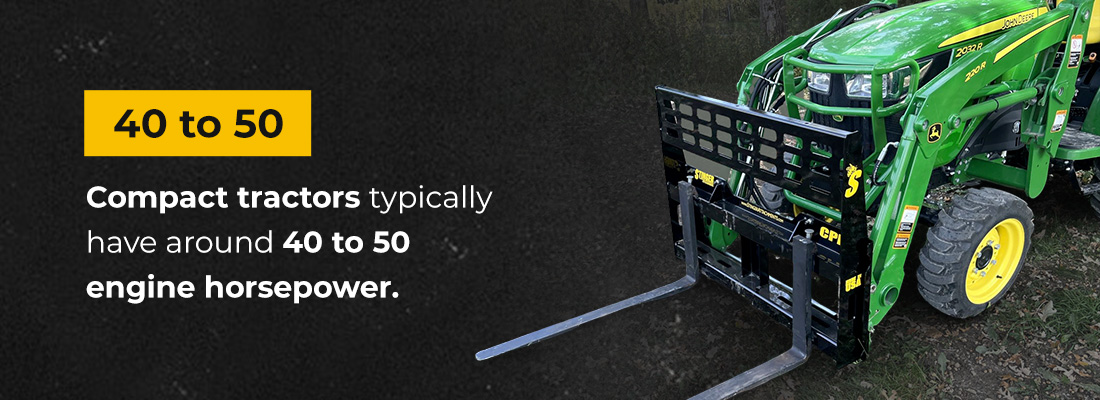
Horsepower gives your tractor the oomph it needs to get the job done. It measures the amount of power in an engine, and tractors come with two types — engine horsepower and power take-off horsepower. PTO horsepower refers to the power used for implements and attachments, such as tillers and mowers.
Compact tractors typically have around 25 to 50 engine horsepower, but you can find models with less and more. At around 25 horsepower, you reach the subcompact category, and above 65 puts you in utility tractor territory. You’ll need additional horsepower to carry or lift heavy loads. More horsepower can also help navigate rough terrain by helping you push through pesky interruptions, like rocks or tree roots.
Consider the work you need to support, and size up when in doubt. You may want to go bigger anyway to give you room for expansion. Extra horsepower could be helpful if you think you’ll start working with heavier loads in the next few years. Still, don’t go overboard — unnecessary horsepower can be inefficient.
2. Know Your Hitch Type
The hitch helps you connect attachments and implements, and compact tractors typically have three-point hitches. Three-point hitches put the implement’s weight and resistance to the drive wheels, giving it more traction. You generally won’t need to choose your hitch type, but you will need to know what it is so you can select appropriately sized implements.
Here are the two primary hitch categories for compact tractors.
- Category 1: A Category 1 hitch is smaller and has a top link pin with a 3/4-inch diameter. It has two 7/8-inch lift arm pins with 26 inches of space between them. These hitches work well on tractors between 20 and 50 horsepower. Watch out for tractors with Category 1 Limited hitches — they may have the same dimensions, but sit lower to the ground and cannot lift implements as high.
- Category 2: A Category 2 hitch fits tractors with higher-powered engines. They have a larger 1-inch top link pin diameter and 1 1/8-inch lift arm pins. The arm spacing is 32 inches.
You may also come across Category 0, 2, 3 and 4 hitches, but these are for smaller and larger models.
3. Pick a Transmission Style
While it’s not quite as simple as picking a transmission on a car, compact tractors also allow you to control your speed in different ways.
If affordability is your biggest concern, a gear transmission could be a good choice. But slow down — they’re best for experienced operators who know their way around a tractor. If you’re new to the game, you’ll probably be better off with another option. Before we talk about those, here are the four types of gear transmissions that seasoned tractor operators can choose from.
- Sliding gear: This simple style puts gears into position with a shift fork. It’s one of the most affordable options.
- Collar shift: Collar shift transmissions have a fork and collar between the gear sets instead of sliding them directly into place, which helps boost reliability.
- Synchro: These transmissions work like collar shifts, but they add a synchronizer that serves as a brake to synchronize speeds between gears, making the shifting process quieter and smoother.
- Power shift: This last model locks gears into place with clutch packs, so the operator doesn’t need to clutch. You can use a button or lever to shift gears.
Try a clutchless power shuttle for a precise, user-friendly transmission. They use electronic controls and hydraulic clutch packs to engage the transmission. They’re more expensive than gear transmissions, but they’re reliable and work well for repetitive forward and reverse movements.
A hydrostatic transmission is the most popular option, behaving like an automatic transmission in a car. It uses hydraulics to power the axles and drive gears for a super smooth ride. You’ll also get precise speed controls, cruise control and electric options that boost power and maneuverability.
An HST is a good choice for loading applications where you don’t need to keep the tractor at a consistent speed. If you’re new to the tractor world, it’s a great all-around performer.
4. Know What Tires You Need
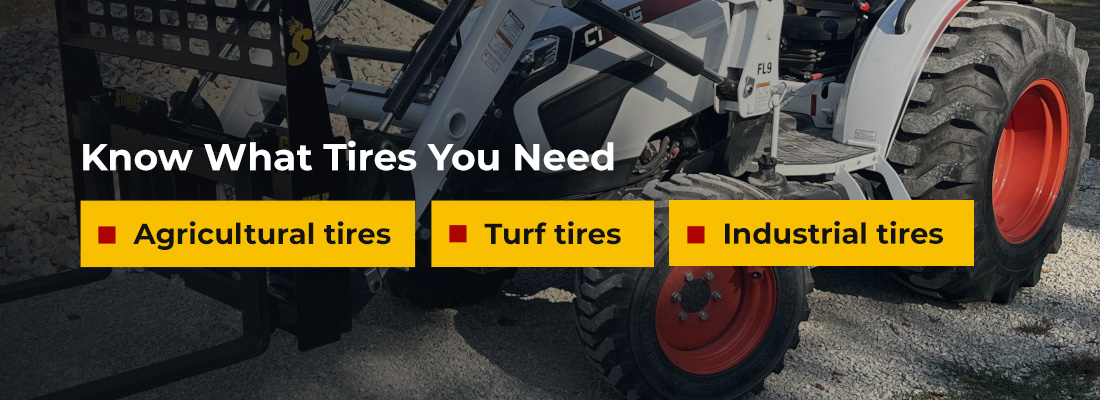
The best tires for your compact tractor will match the terrain you drive on. The rougher and steeper the ground, the deeper the grooves and the more lugs your tires need. Heavy loads and soft or muddy earth can also call for a higher-traction tire.
Most compact tractor tires fall under these three categories.
- Agricultural tires: Designed for a diverse landscape, agricultural tires offer deep lugs, excellent traction and self-cleaning action. They work well even on soft or muddy ground and support heavy loads.
- Turf tires: Pick turf tires if you work on polished lawns and landscaped spaces. They have less traction and perform best in dry weather, but their shallower treads minimize damage to the ground to keep it in good shape while you work.
- Industrial tires: For something more rugged and puncture-proof, go for industrial tires. They have wider treads and deep lugs, and they resist wear on asphalt, concrete and gravel roads.
You’ll also see these tires called R1, R3 and R4 tires, respectively.
5. Consider Your Cabin Style and Visibility Accessories
Want to say goodbye to sweating through summer work or getting drenched during the rain? Choose an enclosed cabin, which offers some excellent features for improving comfort. Air conditioning, heating and rain protection are a few prime examples. Other perks you might find in enclosed cabs include high-tech monitors, speakers for jamming out while you work and protection from bugs and dust.
On the other hand, an open cabin is handy if you need to get in and out of your tractor frequently. It could also be helpful in forestry applications where protruding items could break the glass.
Here are other elements of your cab to consider.
- Rollover protection: A rollover protection system is a crucial safety feature. Tractor rollovers are the deadliest injury on United States farms, yet only about half of tractors have rollover protection. ROPS adds bars or cages that protect the operator during an overturn — and they’re 99% effective in preventing death or severe injuries. Most modern tractors have them, but you may need to keep your eyes peeled if you’re buying an older model.
- Ergonomic features: Who doesn’t want a comfy seat for long workdays? Cabin ergonomics can significanty impact your experience. Suspension seats absorb bumps and vibrations for a smoother ride, while tilting steering wheels help you get a comfortable angle for driving. Cruise control is also handy for reducing tension and strain while working.
- Headlights and mirrors: If you plan to work at night or during foggy conditions, you’ll need good headlights. LED headlights are exceptionally bright and long-lasting. Check out the mirrors to ensure they offer appropriate visibility.
6. Find the Right Attachments
Attachments can turn a compact tractor into a versatile little workhorse. They expand your equipment’s capabilities to include tasks like lifting uniquely shaped objects or plowing snow. You can use many attachments with compact tractors and skid steers, making it easy to adjust your equipment to the task at hand.
Explore the list below and see if any of these compact tractor or skid steer attachments would benefit your workflow.
- Pallet forks: With durable, lightweight tines, a pallet fork attachment can quickly lift and carry pallets across environments for easy transportation. You can also use them for things like moving logs, brush piles and trash cans.
- Compact clam grapples: A compact clam grapple grips material with two convex sides that close around the load. This attachment is for you if you move logs, debris and brush.
- Material buckets: Whether you’re moving dirt, brush, rocks, snow or something else, material bucket attachments for compact tractors and skid steers offer versatile support.
- Bale spears: Ramp up your bale-moving operations with a bale spear attachment that pierces hay for easy and quick handling.
- Snow buckets and pushers: Many farmers, landscapers, homeowners and construction teams use snow-moving attachments to clear a space quickly.
Remember to keep your PTO horsepower in mind when choosing a compact tractor. You’ll need enough to power the attachments you use.
Complete Your Compact Tractor Purchase With Stinger Attachments
Our tractor buying guide should give you a head start in finding the perfect compact tractor. When it’s time to add high-quality attachments, trust the pros at Stinger Attachments. We build reliable equipment with a premium manufacturing process, and we offer speedy turnarounds for in-stock products.
Explore our compact tractor attachments today, or reach out to us with any questions!

